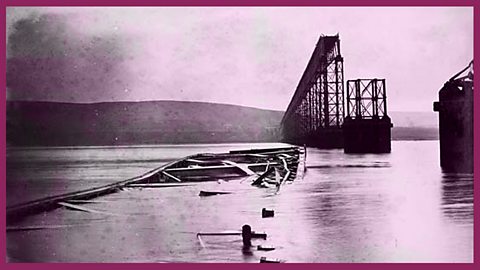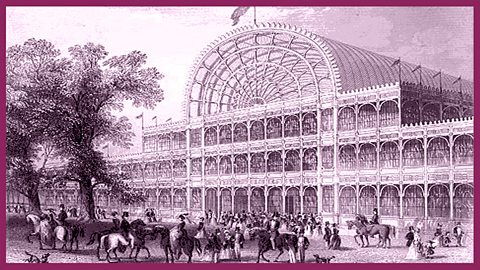Railways - Inventions - Brunel - Seacole - Livingstone - Darling
The resources on this page explore three of Isambard Kingdom Brunel's outstanding achievements:
- the Thames Tunnel - the first tunnel to run under a river
- the Great Western Railway - a new line from London to Bristol and onwards to the West Country
- the SS Great Eastern - the biggest ship of its day and capable of sailing around the world without refuelling
1. 'The shield' - the building of the Thames Tunnel
Synopsis:
Richard Beamish, an engineer, tells of the time when he was employed by Isambard Kingdom Brunel and his father, Marc, to work on the Thames Tunnel. It was 1825 and no one had ever dug a tunnel under a river before. Beamish wanted to know how this would be achieved and Brunel explained the theory behind the 'Shield', a device that his father, Marc, had invented.
The Shield was a huge metal disc with doors in it, which enabled the workmen to stand on it, open the doors and dig out sections of soil to create the tunnel, while the shield kept the rest of the earth in place. However, the River Thames contained a lot of sewage and many workmen working underground collapsed from breathing in the fumes and there was a further problem with water constantly entering and flooding the tunnel. On one occasion Isambard Kingdom Brunel himself was caught up in such a flood. He was badly hurt, but he survived; others were not so fortunate.
It was seven years before work resumed on the tunnel and it was finally finished. And, although Isambard Kingdom Brunel never returned to work on the tunnel after he had recovered, he went on to other challenges and even greater achievementsβ¦

2. The Great Western Railway
Synopsis:
George Clark is an engineer who has been working with Isambard Kingdom Brunel on the building of the Great Western Railway. In 1851 he is taking his assistant, Arthur, on the train from Bristol to London. The purpose of their journey is to visit the Great Exhibition. As they walk up to the station in Bristol, Arthur is amazed by the grandeur of the building, designed by Brunel. The station cost a great deal of money; the directors had been appalled at the amount, but Brunel had persuaded them that this would be no ordinary railway, that it would be the finest railway in the world - and Brunel had got his way.
Amid the smoke, noise and steam, Arthur grows nervous about travelling on the train. George manages to reassure him and the journey goes smoothly until George tells him the story behind Maidenhead Bridge. Brunel had wanted to build a bridge that was low and flat, but the directors were worried about whether the bridge would bear the weight of the trains travelling over it. The directors agreed to Brunel's plans, but only as long as the scaffolding under the bridge was kept in place.
Brunel had agreed to this condition, but had then lowered the scaffolding slightly so that it wasn't actually touching the bridgeβ¦and in fact the scaffolding was eventually washed away when the river flooded. Arthur panics about travelling over an unsupported bridge, until George points out to him that the train has already passed over itβ¦and Arthur didn't even notice!

3. The 'Great Babe' - the building of the SS Great Eastern
Synopsis:
John Russell, a shipbuilder, recalls the time that Isambard Kingdom Brunel asked him to build his latest ship. The ship was called the 'SS Great Eastern' - or, to use the affectionate name that Brunel gave it - the 'Great Babe'. It was to be the biggest of all the ships designed by Brunel and capable of sailing around the world without refuelling. Russell had been shocked to hear that Brunel wanted to launch his ship sideways, instead of the usual lengthways, because of her size. Russell pointed out that he was the one with the greater experience of launching shipsβ¦but Brunel was insistent and would not be dissuaded.
The day of the launch was a huge occasion with important people in attendance. When the moment arrived for the ship to be launched, to the consternation of all assembled, the ship refused to budge and it took several attempts before the ship eventually slipped into the water. However, The 'Great Eastern' was soon sailing regularly across the Atlantic.
Then one day in 1862 on the way to New York she struck a rock, which caused a huge gash down one side. But, instead of taking on water and sinking, as the crew expected, the ship stayed afloat. Any other ship would have sunk, but Brunel had designed the ship with a double hull and only the outer hull had been damaged. Further proof of Brunel's extraordinary expertise in ship design.

Resources

Μύ
Μύ
Play next
Life in a wealthy Victorian family. audio
The story of Emily Anne Barr who lives in a well-off family with servants and a governess

Victorian railways. audio
Exploring the invention of the train and the expansion of the Victorian rail network.

Victorian inventions. audio
βVictorian inventionsβ consists of three episodes about developments in technology during the Victorian era.
